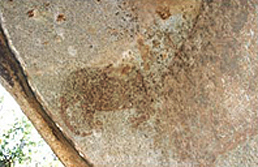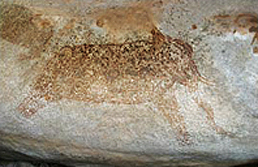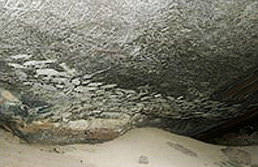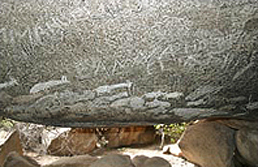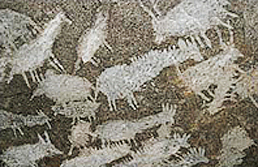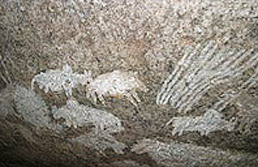 |
 |
Kikonko kya Nzogu |
Site 13 |
Singida Region / Iramba District / Nduguti Division
The name ‘Kikonko kya Nzogu’ means ‘elephants’ hill’ in the dialect of Iambi people, a form of Kinyiramba language. Not only does the name refer to the site, but also to the whole area. It derives from the fact that the site, which is very well known by the local people, has pictures of elephants. A huge inselberg with an equally impressive overhang harbours the site, which overlooks the Masiga river on the west and lies about 100m up the slope from the river. The paintings are on a huge boulder resting on a bedrock outcrop and protected from rain and overhead sun by the overhang above it.
The subject matter consists of two elephants painted in a very realistic style employing curves and lines as the infilling motif and comparable to the streaky style described by M.D. Leakey (1983). One of the elephants is kneeling down and has its head lowered as if in the process of falling down or dying. To the right of the elephant, is a human figure holding what look like spears. The visual clues suggest a hunting scene, but this must be corroborated by ethnographic research. For one thing, spears are not common hunting weapons and are hardly encountered in the rock paintings. Additionally, if the rendering is a realistic depiction of a hunting scene, then we would expect to find many more human figures associated with the scenic portrayal because one person does not bring down an elephant, especially in the absence of poisoned arrows. Perhaps, there is much more meaning in the depiction than what meets the eye. As usual the human figures were depicted in stylised manner.
There was no clear case of superpositioning detected, but the elephants appear to have been painted over some previous paintings now too faint to make out. On the other side of the boulder, are recent designs presumably, Taturu (Barabaig) cattle ownership symbols. Overall, the site is in good state of preservation. There is no indication of artifacts on the floor.
 |
 |
Mguguno |
Site 14 |
Singida Region / Iramba District / Kisiriri Division
Getting to this site is rather arduous being about 6km away from Isanzu Lutheran mission and in the midst of a dense thicket known as Mgumo forest. This factor, more than any other, has offered protection against too much vandalism. In addition, the site is a good distance from the village and away from areas favoured for cultivation.
In physical configuration, it would be described as an exterior cave, since the overhang curves in front to connect with some huge boulders, so that a cave with openings in both directions is formed.
Patches of paint suggest that there have been at least two phases of painting. The first phase is represented by faint drawings of animals in a naturalistic style. These include a huge pachyderm or rhino and several giraffes, executed in red, painted on the ceiling, but which can hardly be made out now. There are more representations in this style, but they are so faint that it would be mere conjecture to attempt identification.
The later phase of paintings consists predominantly of animals in the so-called ‘dirty white’ painted on the lower part of the ceiling and from one end to another. There are also a few anthropomorphic figures. Stylistically, the pictographs fall under what, for want of a better term, has been referred to as ‘the dirty white’, in which the pigment turns out to be ashy or latex white. The animal friezes, which decorate the ceiling of the cave, are semi-naturalistic silhouettes in which details are missing, borders fuzzy and the finished product comparatively poor. As with the case of Kirumi Isumbirira, exceptionally long necked giraffes seem to have been the most popular subject matter. These later paintings appear superimposed on the earlier phase, especially on the ceiling. Elsewhere, cases of superimposition can only be guessed at.
Of special interest is the fact that some of the pictures appear to represent domestic animals such as the cow and possibly the dog. The historical significance of this observation is immense for it could provide an independent clue about the introduction of domestic animals to the central Tanzania area, but this identification is still tentative pending further study.The site is also stratified with archaeological deposits and like many of the best rock art sites in Singida, Iramba, and Lake Eyasi, it has been disturbed by cave robbers hunting for German gold coins. Overall the site is in good state of preservation and since it is rather difficult to reach, it is not greatly threatened by vandalism.
→
Rock Art in Tanzania
→
Tanzania Rock Art - Forward by Dr. Meave Leakey
→
Overview of Tanzania Rock Art Sites
→
Tanzania Conservation & Management
→
Tanzania Rock Art Sites|
1-2 |
3-6 |
7-9 |
10-12 |
13-14 |
15-16 |
17-18 |
19-21 |
22-24 |
25-26 |
→
Africa Rock Art Archive
→
Bradshaw Foundation
Like us on Facebook & Follow us on Twitter to receive news & updates:
